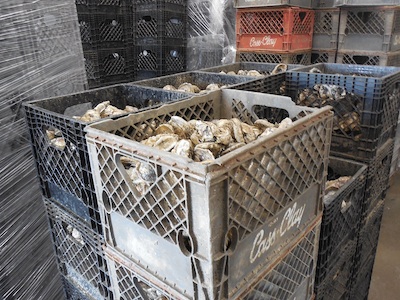When you write about commercial fishing, you write a lot about the downturns, the small fishermen squeezed out, the sinkings, the disappearance of working waterfronts and rising fuel bills (you get the picture). Sometimes, you just want to put some good news out there too, even if it means you have to dig a little to find it.
That's especially true for the Gulf of Mexico. When I visited Louisiana a couple weeks ago, a cold, wet spring had deflated blue crab production there. If that wasn’t bad enough for gulf fishermen, they’re also contending with oysters not being as productive as expected. But despite the bad news, I also heard optimistic predictions about oysters.
Chris Nelson, of Bon Secour Fisheries in Bon Secour, Ala., has survived a downturn before. His father started Bon Secour after returning from World War II. When he was in high school, Nelson remembers the company had 80 shrimp boats. Those were mostly sold out in the early 2000s; now they have two.
Nelson, whose great-grandfather was an oysterman, compared the species’ slow recovery to a cork pushed down into a bottle. The gulf, its seafood and fishermen, have taken some big hits over the last few years, from multiple hurricanes to the oil spill and the fresh water used to combat it that harmed oyster beds in its path:
“All those things individually would have been a problem, having them — boom, boom, boom, boom, boom, boom — it just pushed the resource down to the point where it’s taking longer to recover,” he said.
The good news? A slow recovery is better than no recovery, and the area is still prime for oyster production: “Louisiana is tremendously productive in its ability to grow oysters,” he said.
Let's hope "normal conditions" return soon. Instead of fresh water, too much salt water has been part of the problem this year, Steve Otwell, a seafood safety specialist at the University of Florida, told me. He’s a fascinating person to talk to about oysters (I interviewed him for a separate story I wrote for SeaFood Business) because he knows so much about them. He predicted oysters would return to normal production if the drought doesn’t continue.
One issue that was brought up several times was better marketing of oysters that come out of the gulf so that they are no longer a commodity, but a premium product that people pay more for — and fishermen make more money. The example you usually hear during these discussions is Alaska’s success making Copper River salmon a brand name.
Otwell says he has advocated for more oyster appellations for years. Appellations use geographic names to build distinction among products (like how wine is named after the regions the grapes are grown in). “It just builds a lot of romance back into the product,” he said.
He obviously felt strongly about making more Gulf oysters into household names. It makes sense as people love them even without the marketing effort.
“It’s such a powerful preference,” he said. “People demand that they want it raw, wow! How many products do we demand raw? Not many protein products. How many people want raw chicken? I don’t know anybody — that’s a pretty powerful preference.”
Above photo taken by Melissa Wood at Motivatit Seafoods in Houma, La.







